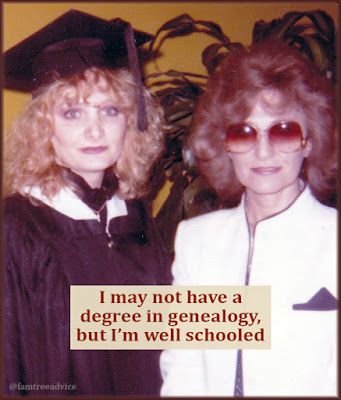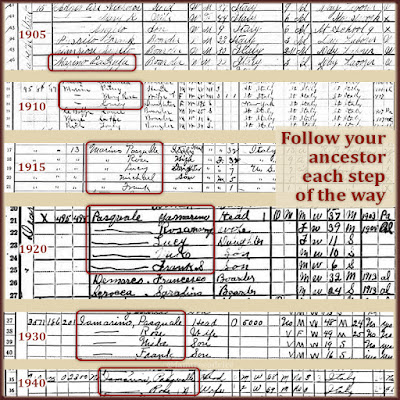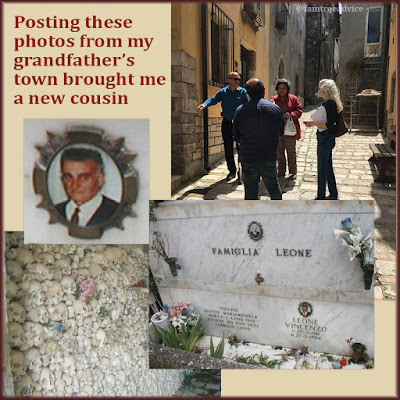How hard you work at genealogy depends on motivation, and a touch of fever.
Everyone has a reason for starting to build their family tree. What was yours? Was it:
- to solve a family mystery?
- to connect to your roots?
- health and heredity needs?
- a search for royal or famous ancestors?
- a school assignment?
- because everybody else is doing it?
Once you catch genealogy fever, you may forget your first motivation. And if you have caught the fever, that's good. You'll be more likely to practice thorough, careful genealogy.
Here's how my own interest began, and where I am now.
In 2003 as I was planning my wedding, my husband-to-be was planning our honeymoon in Italy. I'd never been to Italy, and I knew so little about my family history there. It was at my wedding that I learned my great grandmother's last name was Caruso.
 |
| Here's the moment my genealogy obsession began, in Grandpa's hometown. |
While staying in Sorrento, we took a day trip to the town where my grandfather was born: Colle Sannita. It was a life-changing experience for me. I felt as if something were calling to me. I felt I belonged there. I felt as if I could melt into the ground itself.
Back home, I wanted to learn more. Where did the branches of my family tree begin hundreds of years ago?
That strong emotional feeling I had in Italy made me start working on my family tree.
Today, 16 years later, I've got a carefully built family tree with more than 20,000 people. Nearly every Italian in my tree was born within a 15-mile radius. That means I can harvest thousands of relatives from the vital records of one town. And I did. I found out I'm related by blood or marriage to almost everyone in my grandfathers' hometowns.
Some will say that what I'm doing is not family history. Well, my ancestors were illiterate. They survived by working their land. These vital records are all that remains.
If my obsessive labor of love sounds crazy, consider this:
DNA Matches
The more families I build from these 19th century documents, the more DNA matches I can connect to. I've had a lot of luck lately picking a DNA match with any size tree, and working to find our connection. As I build more families, I'm building connections to more of my DNA matches.
Generations
My "overkill" approach is the reason I know the names of a good number of my 6th, 7th, and 8th great grandparents. Maybe I had to find marriage records for a bunch of siblings before I found the earlier generation. To me, it's totally worth the effort.
 |
| How much will you miss if you only look at your direct ancestors? |
Hometown Knowledge
Deep dives into my towns' documents made me familiar with:
- the townspeople's last names
- the street and neighborhood names
- some of their customs.
I'm no longer shocked when a 19th century Italian man remarries one month after his wife died. Seeing how common it was for a widower to marry a much younger woman and have more kids helped me. It's no longer gross that my great great grandfather's second wife was his daughter's age.
I took my obsessive genealogy techniques to a new level this past weekend. I started looking at every document in my vital record collection. These are the thousands of documents I downloaded from my ancestral hometowns. I'm reviewing each one and seeing if it fits in my tree. If it does:
- I crop the document image in Photoshop
- add information to the image file
- add the document to that person in Family Tree Maker
- make note of it in my document tracker
- turn that line green in my inventory spreadsheet. Green means it's in my family tree.
 |
| As I add more documents, my family tree becomes stronger. |
So far, I did this for one towns' 1809 births, deaths, and marriages. The moment I finished, I moved on to 1810 births. It's crazy to think how many people and relationships I'll add to my tree by doing this.
Not as obsessed as me? OK. You don't have to piece together the family of your 5th cousin 4 times removed. But I'll keep going.
Because the people from these documents are more than names and dates. They're calling to me. We belong to one another. They are what makes my family tree come alive.





















